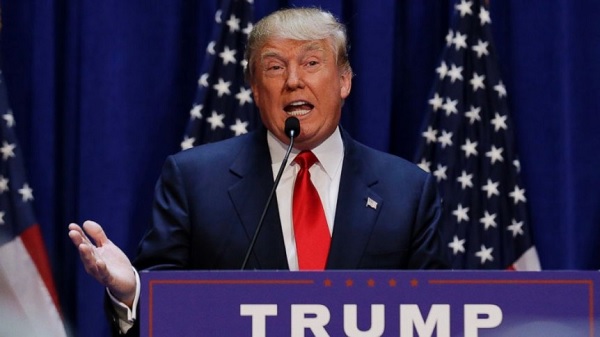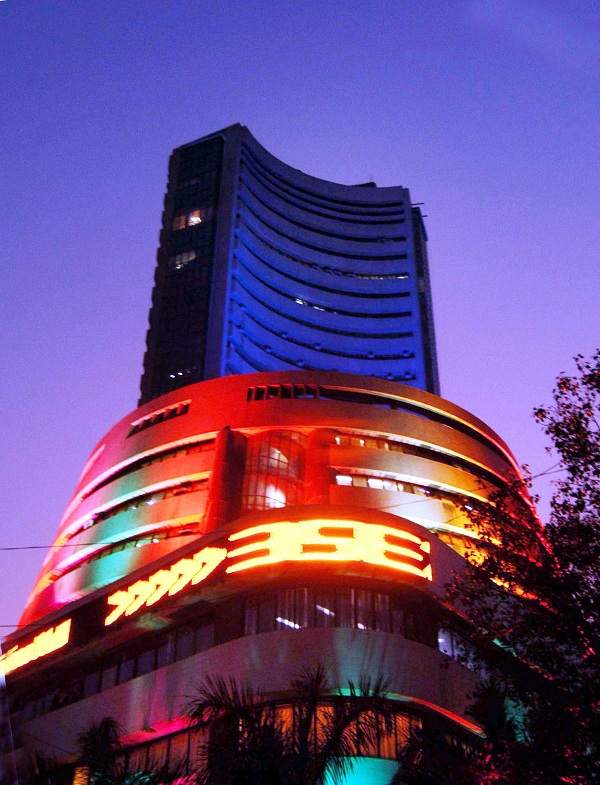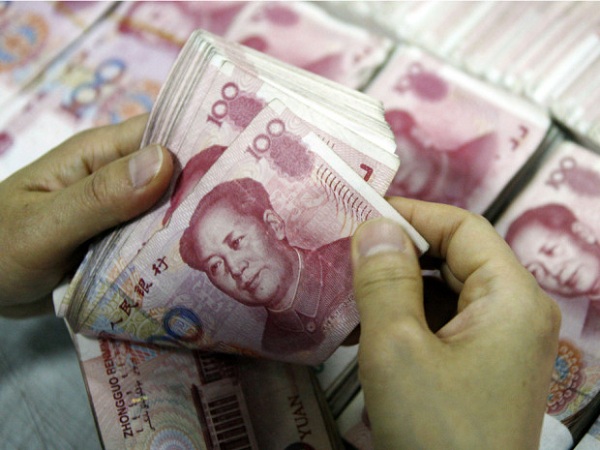
by Editor | May 25, 2021 | World

Republican presidential front-runner Donald Trump
Washington:(IANS/EFE) Republican presidential candidates used the Wall Street market crash to launch an attack on China and President Barack Obama’s foreign policy.
Republican presidential front-runner Donald Trump, who has repeatedly criticised the US for submitting to China, blamed Beijing’s policy for the crash at Dow Jones at 589 points on Monday.
“Markets are crashing – all caused by poor planning and allowing China and Asia to dictate the agenda. This could get very messy! Vote Trump,” the real estate magnate wrote on Twitter.
“I’ve been talking about China for years. Because China is going bad, it’s going to bring us down too because we are so heavily coupled with China,” he said.
Another Republican presidential favourite Scott Walker urged President Obama to withdraw the invitation to Chinese President Xi Jinping, expected to visit the US in September, EFE reported on Tuesday.
“Americans are struggling to cope with the fall in today’s markets, driven in part by China’s slowing economy and the fact that they actively manipulate their economy,” Walker said in a statement.
Walker added: “Given China’s massive cyber attacks against America, its militarisation of the South China Sea, continued state interference with its economy, and persistent persecution of Christians and human rights activists, Obama should make China pay for its several attempts to weaken U.S. interests, instead of arranging a state visit for Xi.”
New Jersey governor Chris Christie said the market crash was a consequence of Obama’s “failed policies”.
“This president doesn’t know how to say no to spending, doesn’t know how to say no to a bigger and more intrusive government,” Christie said.
Carlier Fiorina, the only female Republican presidential candidate, said the fall is a sign the US economy is weakening.
The Wall Street crash was caused by strong setbacks in Asia, affected by the devaluation of the Chinese currency yuan and signs of an economic slowdown in the world’s second-largest, but heavily state-controlled, economy.

by Editor | May 25, 2021 | Corporate, Corporate finance

Bombay Stock Exchange
Mumbai:(IANS) After an initial surge, Indian share markets fell again on Tuesday, in line with global cues, a day after the mayhem in global financial markets and a crash in China spooked a key Mumbai index into shedding some 1,625 points, or nearly 6 percent.
The sensitive index (Sensex) of the Bombay Stock Exchange (BSE) opened at 25,916.26 points, against the previous close at 25,741.56 points, and a few minutes into trading it was ruling at 26,091.71 points, with a gain of 349.15 points, or 1.36 percent.
But around 11:30 in the morning, the index was ruling at 25,408.95 points, with a loss of 332.61 points or 1.29 percent. Five out of the 30 shares that go into the Sensex basket, however, managed to buck the trend and were ruling higher than the previous close.
Overall, in the volatile session of Tuesday, out of 2,416 stocks that were being traded, 1,981 were quoting lower, 373 of them advanced, while 12 others were unchanged.
A similar trend played out at the the National Stock Exchange (NSE), where the broader 50-share CNX Nifty was initially ruling higher at 7,910.45 points, with a gain of 101.35 points, or 1.30 percent. But it soon fell to 7,707 points, with a loss of 102 points, or 1.31 percent.
Weak global cues and the shock from China where the markets crashed over fears that its economy was slowing faster than expected sent Indian indices and the rupee into a tailspin on Monday. The Sensex logged its steepest closing fall in point-terms. The rupee fell to a two-year low.
Key US indices also took a tumble of around 4 percent.
A day later, the investor sentiments continued to be grim globally. Tokyo’s Nikkei opened nearly 2 percent lower on Tuesday, and the bloodbath in China continued unabated. The Shanghai Composite index opened 6.2 percent lower.

by Editor | May 25, 2021 | Business, Economy, News

Rupees five hundred
By Rohit Vaid
Mumbai:(IANS) A crashing rupee, disappointing results and diminishing rate cut hopes coupled with profit bookings on concerns over commodities prices, consumer sentiments and China drowned the Indian equity markets last week.
Bearish sentiments ruined investor sentiments– plunging the barometer 30-scrip sensitive index (Sensex) of the S&P Bombay Stock Exchange (BSE) by over 700 points or around 2.50 percent.
The Sensex ended last week at 27,366.07 points from 28,067.31 points closing on August 14. The benchmark index fell around 170 points or 0.59 percent during the previous weekly trade (August 14).
“The currency market slide has been the major theme last week in India, overshadowing several positive announcements favouring banking sector, as well as the overall economy,” Anand James, co-head, technical research, Geojit BNP Paribas, told IANS.
As per James, the continuous slide in rupee value which resulted in Friday’s close of Rs.65.83, a new 2-year low and breaching of the Rs.66 to a dollar mark in futures markets unnerved investors.
On the bright side James pointed that: “The slide in currencies and equity markets has not yet reached a panic state.”
The major catalyst for the rupee’s slide has been the devaluation of yuan, intended to boost Chinese exports.
China’s central bank had devalued the yuan by two percent on August 11. This was the biggest devaluation of Chinese currency since 1994. The currency fell again by another two percent on August 12 panicking the world economy.
The move strengthened the dollar value, which has negatively impacted major world currencies including the Indian rupee. The yuan has fallen by 4.6 percent till now since August 11.
Devendra Nevgi, chief executive of ZyFin Advisors, told IANS that if the Chinese markets continue to lose steam then further yuan devaluation can take place.
“The Chinese government, brokerage firms and mutual funds aren’t able to arrest the fall in their markets. Though unrelated, the stock market crash can transform into further yuan devaluation to perk up the economy,” Nevgi cautioned.
Some estimates point out that the continuous slide in the exchanges of the Chinese economy has wiped off 40-45 percent of the entire stock value in the last three months.
Rahul Dholam, senior analyst with Angel Broking, said that yuan devaluation at a time of global slowdown, commodities price crash and the likelihood of the US Fed raising interest rates has set a scenario for the start of currency wars.
“The Indian benchmark indices fell this week led by global concerns over the slowdown in the Chinese economy, fall in oil, other commodity prices and fears of a currency war led by the yuan devaluation,” Dholam elaborated to IANS.
The Indian markets were also shaken by the weak Caixin (China manufacturing purchasing managers’ index) for August. Caixin is a barometer of factory output in the $10 trillion dollar Chinese economy.
Vineeta Mahnot, equity research analyst with Hem Securities, highlighted that the sell off by foreign portfolio investors (FPIs) on subdued earnings, stalled reforms, investment derailment and downward spiral in capital goods manufacturing brought the markets down.
“Sharp sell offs were triggered on worries over subdued corporate earnings, sell off by FPIs and profit booking dampened the sentiments,” Mahnot added.
Other worries for investors have stemmed from the fact that the Reserve Bank of India (RBI) has shown its reluctance to cut interest rates even after current data showed inflation being under control.
“Extended slide in oil prices has cast doubts on the chances of US Fed’s rate hike. This gives RBI a rope for pushing rates lower. However, the central bank is likely to wait till Federal Open Market Committee (FOMC),” James added.
According to James, the stalling of the reforms process — especially the deadlock over the GST (goods and services tax) bill — has demoralised investors and cast a shadow over the government’s push for better economic policies and ease of doing business in India.
Another dampener in last week’s trade was global credit ratings agency Moody’s decision to lower India’s growth forecast for this year by 50 basis points to seven percent.
(Rohit Vaid can be contacted at rohit.v@ians.in)

by Editor | May 25, 2021 | B-School, Web Exclusive
 Wellington:(IANS) Students from India and China helped to drive a record net gain in migrants to New Zealand in the first half of 2015, the government statistics agency said on Friday.
Wellington:(IANS) Students from India and China helped to drive a record net gain in migrants to New Zealand in the first half of 2015, the government statistics agency said on Friday.
Annual permanent and long-term migration showed a record net gain — the number of arrivals over departures — of 59,600 migrants till July this year, resulting from 117,100 arrivals and 57,500 departures, Xinhua cited the Statistics New Zealand.
Of the arrivals, 13,800 were from India, with three-quarters having student visas, and 10,400 were from China.
July also set a record with the highest ever monthly net gain in migrants at 5,700, surpassing the previous record of 5,400 set in January this year.
The influx of migrants would put a strain on all public services, including hospitals, and demand for housing, especially in the overheated market of Auckland, the opposition New Zealand First party said.

by Editor | May 25, 2021 | Opinions

Photo Credit: FinancialExpress
By Vatsal Srivastava
Devaluing the domestic currency during gloomy economic conditions has always been an important and crucial ammunition tool for policymakers.
In the recent past, almost all major developed countries have adopted this approach. When the European Central Bank announces QE and sends the Euro tumbling, it is for a strong and united Europe. When Japan announces the largest bond buying program in financial history (as a percentage of the monetary base) and sends the yen on a freefall, it is because of the dismal demographic trends. When the United States QE program sends the Dollar Index to multi-year lows, it is to save the global economy. But when the People’s Bank of China (PBOC) devalues the yuan by two percent, it is an all out currency war! However, that is not the case.
This is mainly because Chinese officials still have sufficient policy ammunition to boost domestic demand to offset external headwinds. Consensus forecast is for another 25bps policy rate cut and 200bps reserve ratio cut in the second half of 2015. Further, the change in the USD-CNY fixing mechanism will not impede RMB internationalization efforts.
First and foremost, China’s move has most-affected the foreign exchange market – an asset class which is usually most susceptible to overshooting and trading at levels which are not warranted as per the fundamentals. The long-term impact of this intervention by the PBOC will only be known in a few weeks depending on how actively they decide to further devalue the yuan, if at all they do.
Of course, this move will provide relief to its ailing economy. A weaker yuan will make exports more competitive and imports more expensive. Thus, the short-term economic aim is diverting both internal and external demand to domestic production – at the expense of foreign suppliers. Now, before we start calling China a currency manipulator and accusing it of making the world trade markets an uneven playing field, we should remember the following: China’s exports have continued to rise as a share of global exports so there is little indication that CNY had appreciated to a level that had made China materially non-competitive despite the strong appreciation of CNY since 2012. So clearly, the currency war view does not add up just yet.
The bigger theme in play here is China’s attempt to meet the IMF criteria for being included in the Special Drawing Rights (SDR). The PBOC announcement effectively means to allow the market to play a bigger role in the formation of daily fixing. Now, market makers will submit their quotations of RMB central parity by referencing to the closing rate of the previous day (vs previously asking for the price quotations from market makers before the market starts).
This clearly goes to show that China’s central bank is accelerating reforms to raise the chance of the RMB’s inclusion in the IMF’s SDR basket. Although it is not explicitly mentioned, it is nevertheless understood that a reserve currency cannot be a highly managed one (which was the case with the yuan), which could potentially deviate from its underlying fundamental value thereby resulting in eventual instability. That was indeed the risk for USD-CNY, which has been held very steady, despite ongoing capital outflows from China. We can expect the PBOC to announce further FX reforms – such as the extension of the CNY trading hours and promoting convergence between the onshore and offshore exchange rates.
In the short-term, volatile moves in the markets as a result of the Yuan devaluation will make the headlines. But China only stands to gain over the long term by adopting a more efficient and market determined exchange rate.
(Vatsal Srivastava is consulting editor with IANS. The views expressed are personal. He can be reached at vatsal.sriv@gmail.com)





